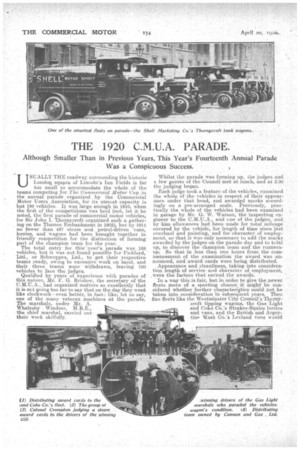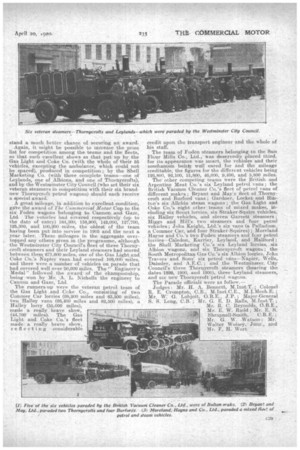THE 1920 C.M.U.A. PARADE.
Page 14

Page 15

If you've noticed an error in this article please click here to report it so we can fix it.
Although Smaller Than in Previous Years, This Year's Fourteenth Annual Parade Was a Conspicuous Success.
USTJALLY THE roadway surrounding the historic London, square of Lincoln's Inn Fields is far too small to accommodate the whole of the teams competing for The Commercial Motor Cup in the annual parade organized by the Commercial Motor Users Association, for its utmost capacity ia but 180 vehicles. It was large enough in 1910, when the firgt of the competitions was held (not, let it be noted, the first parade of commercial motor vehicles, for Sir John L Thornycroft organized. such a gathering on the Thames Embankment in 1902), but by 1914 no fewer than 487 steam and petrol-driven vans, lorries, and wagons had been brought together in friendly competition for the distinctionof forming part of the champion team for the year. The total entry for this year's parade was .168 vehicles, but it was not found passible for Pickford, Ltd., or Schweppes, Ltd., to get their respective teams ready; awing to excessive -work on hand, and their three teams were withdrawn, leaving 150 vehicles to face the judges.
Qualified by years of experience with parades of this nature, Mr. F. G. Bristow, the secretary of the C.M.T.T.A., had organized matters so excellently that it is not. going too far to say that on the day they went like clockwork—even better, in fact: like, let us say, one of the many veteran machines at the parade. The marshals, under Mr. A. Whalesby Windsor, M.B.E., the chief marshal, carried out.. their work skilfully. Whilst (he parade was forming up, the judges and a few guests of the Council met at lunch, and at 2.30 the judging began.
Each judge tooka feature of the vehicles, examined the whole of the vehicles in respectof their appearance under that head, and awarded marks accordingly on a pre-arranged scale. Previously, practically the whole of the vehicles had been examined in garage by Mr. G. W. Watson, the inspecting engineer to the C.M.C.A.. and one of the judges, and by him allowances had. been made for total mileage covered by the vehicle, for length of time since last overhaul and painting, and for character of employment, so that it was only necessary to add the marks awarded by the judges on the parade day and to total up, to discover the champion team and the. runnersupSo that in less than two hours from the commencementof the examination the award was announced, and award cards were being distributed.
Appearance and cleanliness, taking into cOnsideration length of service and character of employment, ,were the factors that earned the awards.
In a way this is fair, but in order to give the newer fleets more of a sporting chance it inighi be considered whether further characterigtics mold not be taken into consideration in spbsequent years. Then fine fleets like the Westminster City Council's Thornycroft tipping wagons, the Gas Light and Coke Co.'s Straker-Squire lorries and. vans, and the British and Argentine Meat Co.'s Leyland Vans would
stand a much better chance of securing an award.
Again, it might be possible to increase the prize list for competition among the teams and the fleets, 80 that such excellent shows as that put up by the Gas Light and Coke Co. (with the whole of their 55 vehicles, excepting the ambulance, which could not be spared), produced in competition ; by the Shell Marketing Co. (with three complete teams—one -of Leylancla one of Albions, and one of Thornycrofts), and by the Westminster City Council (who set their six veteran steamers in competition with their six brandnew .Thornycrcit petrol wagons) should each receive a special award.
A great mileage, in addition to excellent condition, gave the award tif The Commercial Motor Cup to the six Porten wagons belonging to Cannon and Gaze, Ltd, The vehicles had covered respectively (up to the date of entry) 164,300, 158,900, 142,000, 127,700, 125,300, and 100,200 miles, the oldest .of the team having been put into service in 1905 and the next a year later: These mileages in the aggregate over
tapped any others given in the programme, although the Westminster City Councils fleet of three Thornycroft steamers and their Leyland steamers had scored between them 671,600 miles, one of the Gas Light and Coke Co.'s Napier vans had covered 108,000 miles, and there were a number of vehicles on parade that , had covered well over '50,000 Miles. The I Engineer's Medal" followed the award of the -championship, being won by Mr. A. L. Nicholls the engineer to Cannon and Gaze, Ltd. The runners-up were the veteran petrol team of the Gas Light and Coke Co., consisting of two Corumer car lorries (68,200 miles and 63,600 miles), two Halley vans (66,400 miles and 62,500 miles), a Halley lorry (55,000 miles), made a really . brave show, (44,700 miles). The Gas Light and Coke Co.'s fleet made, a really brave show, reflecti n-g considerable credit upon the transport engineer and the whole of his staff.
The team of Foden steamers belonging to the Sun Flour Mills Co., Ltd., was deservedly pla.c.ed third, for its appearance was smart, the vehicles and their mechanism beir.kg well oared for and, the mileage creditable, the figures for the different vehicles being 126,800, 92,10C), 51,800, 46,000, 9,400, and. 5.800 mites. The other Competing Learns were the British and Argentine Meat Co.'s six Leyland petrol vans ; the British Vacuum Cleaner Co.'s 'fleet of petrol vans of different makes; Bryant and May's fleet of Thornycroft and Burford vans ; Gardner, Locket and Hin ton's six -All,chin steam wagons ; the Gas Light and Coke CO: eight other teams of mixed makes, including six Scout lorries, six Straker-Squire Vehicles, six Halley vehicles, and eleven Garrett steamers; Higgs and Hill's two steamers and four petrol vehicles; John Knight, Ltd.'s six vans (a Palladium. Commer Car, and four Straker-Squires); Moreland ilayne and Co.'s two Foden steamers and four petrol lorries—Caledon, liarrier, Leyland, and Hanford ; the Shell Marketing Co.'s six Leyland lorries, six Albion wagons, and six Thorny-aro-ft wagons ; the South Metropolitan Gas Co.'s six Albion lorries, John Travers and Sons' six petrol vans—Napier, Wells, Daimler, and A.E.C. ; and the Westminster City
Council's three .Thornycroft steamers (bearing the -dates -1899, 1900, and 1900), three Leyla,nd steamers, and six new Thornyeroft-petrol wagons.
The Parade officials were as follow.— Judges : Mr. H. A. Bennett, M.Inst.T..• Colonel R. E. Crompton, C.B.. M.Inst.C.E., Mr. W: G. Lohjoit, 0.B.E., J.P. • Major-General S„ S. Long, C.B. ; Mr. G. E. 1). RaIls, ALInst.T. ; Mr. 11. C. .Reynolds, 0..B.E., Mr. E. W. Build; Mr. E. S.
Shrapnell-Sinith, ; Mr. G. W. Watson ; Mr. Walter Wolsey, junr., and Mr. F. H. Wort . •




























